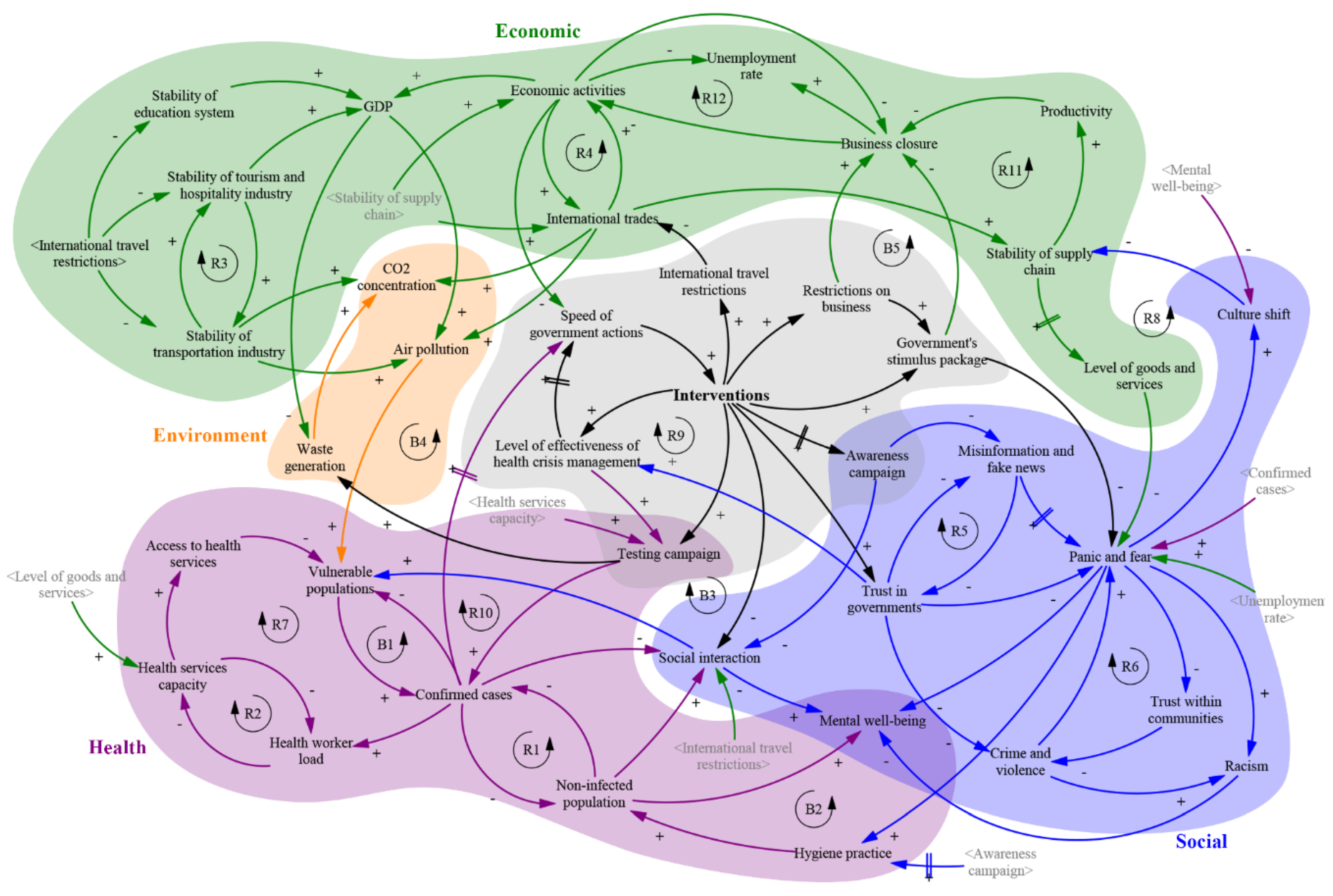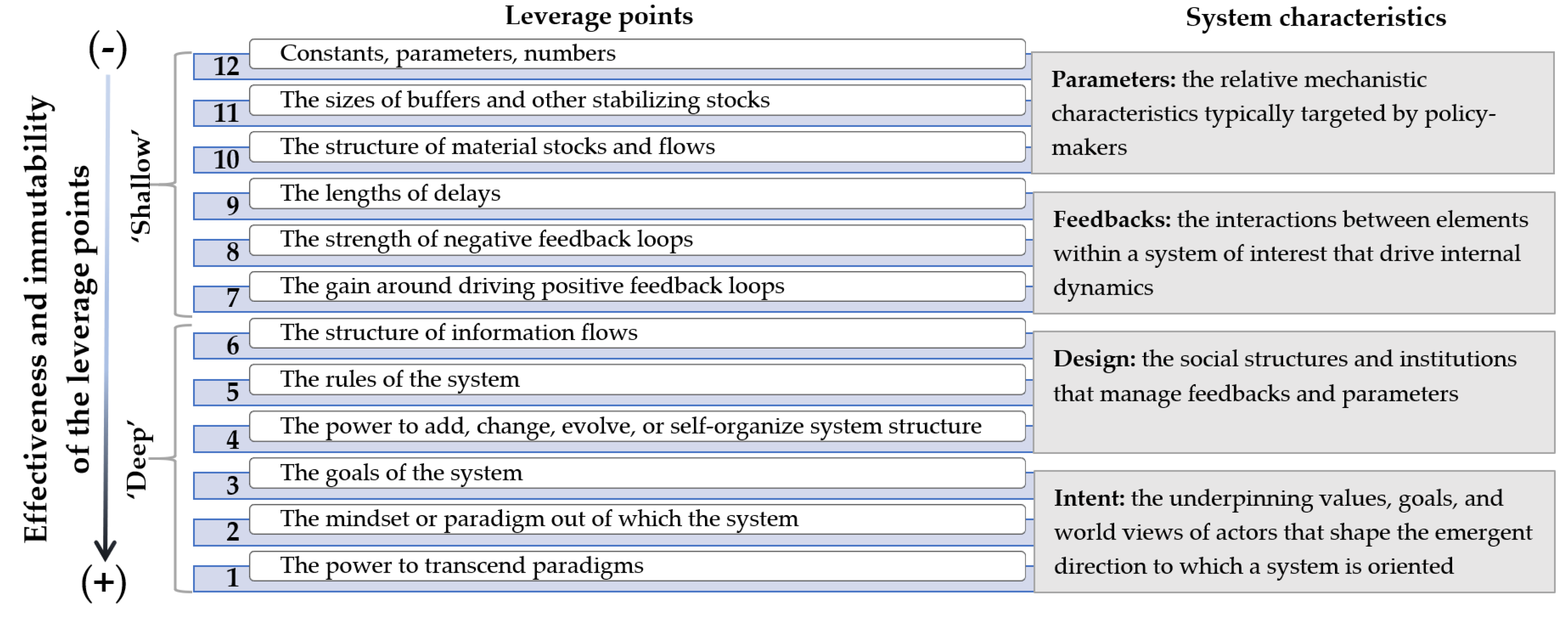Developing a Preliminary Causal Loop Diagram for Understanding the Wicked Complexity of the COVID-19 Pandemic
Abstract
1. Introduction
2. A Wicked Complexity
3. Placing Interventions in the Right Place at the Right Time
4. Lessons Learned
Author Contributions
Funding
Conflicts of Interest
Glossary
| Variable Name | Description |
| Access to health services | Access into the health care system |
| Air pollution | The amount of harmful substances in earth’s atmosphere |
| Awareness campaign | Marketing effort to educate individuals about an issue (e.g., need in regular hand washing, coverage of coughing/sneezing, usage of tissues and bin tissues, etc.) |
| Business closure | Closure of businesses due both temporarily and due to bankruptcy |
| CO2 concentration | Concentration of carbon dioxide in earth’s atmosphere |
| Confirmed cases | Positive tested population |
| Crime and violence | Intentional harm |
| Culture shift | Shift in communities’ culture (e.g., panic buying, business culture, etc.) |
| Economic activities | Stable manufacture of goods and the provision of services |
| GDP | Gross domestic product |
| Government’s stimulus package | Government’s financial assistance to support businesses, households, and individuals |
| Health care worker load | Number of patients per health care professional |
| Health services capacity | Availability of facial masks, hospital beds, medication, treating medical staff, public health services |
| Hygiene practice | Regular hand washing, coverage of coughing/sneezing, usage of tissues and bin tissues |
| International trades | Export and import of goods and services |
| International travel restrictions | Travel ban to international flights to curb imported cases |
| Interventions | Action plan of the government to controlling pandemic and its impacts |
| Level of effectiveness of government health crisis actions | Effective operational action plan of the government; innovative steps to enable an effective intervention |
| Level of goods and services | Goods and services available in the market |
| Mental well-being | Social and emotional well-being of individuals |
| Misinformation and fake news | Pseudo-news, deliberate disinformation, conspiracy theories or hoaxes spread via traditional news media or online social media |
| Non-infected population | Fatalities, recovered, negative tested, non-tested population |
| Panic and fear | Sudden anxiety, hysterical and irrational behaviour |
| Productivity | Rate of goods and services being produced |
| Racism | Prejudice, discrimination, or hatred directed at someone because of their colour, ethnicity or national origin |
| Restrictions on business | Temporarily closure of non-essential businesses, ‘take-away’ only policy |
| Social interaction | Ability to meet (an)other individual(s) |
| Speed of government actions | Coordinated and timely operational action plan of the government to address health crisis |
| Stability of education system | Uninterrupted work of education institutes, high number of enrolled international students at universities |
| Stability of supply chain | Uninterrupted distribution of goods and services, (i.e., no delays), availability of goods and services available in the market |
| Stability of tourism and hospitality industry | Uninterrupted flow of both international and domestic visitors, stable work of hospitality businesses and events |
| Stability of transportation industry | Stable work of airlines, train services, shipping industries |
| Testing campaign | Campaign to promote public awareness about COVID-19 testing if they have any symptom |
| Trust in governments | Community trust and confidence towards parliament, the cabinet, the civil service, local councils, political parties, politicians |
| Trust within communities | The degree of trust towards a certain group of people |
| Unemployment rate | Share of the labour force that is jobless |
| Vulnerable populations | Elderly, socioeconomically disadvantaged (uninsured, homeless), individuals with a pre-existing medical condition |
| Waste generation | The amount of waste generated by households, industries and health systems |
Appendix A
| Modelling Workshops | Purpose | Date and Meeting Format | Number of Participants | Participants’ Area of Expertise ** | Confirmed COVID-19 Cases, Australia |
|---|---|---|---|---|---|
| Workshop 1: Problem scoping |
| March 10 2020; Face-to-face | 5 | PH, S, CC, EM, ST, MS, G, E, EngM | 116 |
| Workshop 2: Model conceptualisation |
| March 24 2020; Face-to-face | 7 | PH, S, CC, EM, ST, MS, G, EngM, E, F, B | 2317 |
| Workshop 3: Model confirmation |
| March 29 2020; Video conferencing * | 7 | PH, S, CC, EM, ST, MS, EngM, G, E, F, B | 4163 |
| Workshop 4: Model confirmation (Cont.) |
| April 5 2020; Video conferencing * | 4 | S, CC, EM, ST, MS, EngM, G, E | 5750 |
References
- Norman, C.D. Health promotion as a systems science and practice. J. Eval. Clean. Pract. 2009, 15, 868–872. [Google Scholar] [CrossRef] [PubMed]
- Wearden, G.; Jolly, W. IMF: Global Economy Faces Worst Recession Since the Great Depression—As It Happened. The Guardian. 15 April 2020. Available online: https://www.theguardian.com/business/live/2020/apr/14/stock-markets-china-trade-global-recession-imf-forecasts-covid-19-business-live (accessed on 20 April 2020).
- Anderson, R.M.; Heesterbeek, H.; Klinkenberg, D.; Hollingsworth, T.D. How will country-based mitigation measures influence the course of the COVID-19 epidemic? Lancet 2020, 395, 931–934. [Google Scholar] [CrossRef]
- Prompetchara, E.; Ketloy, C.; Palaga, T. Immune responses in COVID-19 and potential vaccines: Lessons learned from SARS and MERS epidemic. Asian Pac. J. Allergy 2020, 38, 1–9. [Google Scholar] [CrossRef]
- Barron, L. What We Can Learn from Singapore, Taiwan and Hong Kong about Handling Coronavirus. Time. 13 March 2020. Available online: https://time.com/5802293/coronavirus-covid19-singapore-hong-kong-taiwan/ (accessed on 22 April 2020).
- Da Luke, D.A.; Stamatakis, K.A. System science methods in public health: Dynamics, networks, and agents. Annu. Rev. Public Health 2012, 33, 357–376. [Google Scholar] [CrossRef] [PubMed]
- Suprun, E.; Sahin, O.; Stewart, R.A.; Panuwatwanich, K. Model of the Russian Federation construction innovation system: An integrated participatory systems approach. Systems 2016, 4, 29. [Google Scholar] [CrossRef]
- Meadows, D.H. Thinking in Systems; Chelsea Green Publishing: White River Junction, VT, USA, 2008. [Google Scholar]
- Bureš, V. A method for simplification of complex group causal loop diagrams based on endogenisation, encapsulation and order-oriented reduction. Systems 2017, 5, 46. [Google Scholar] [CrossRef]
- Agnew, S.; Smith, C.; Dargusch, P. Causal loop modelling of residential solar and battery adoption dynamics: A case study of Queensland, Australia. J. Clean. Prod. 2018, 172, 2363–2373. [Google Scholar] [CrossRef]
- Garrity, E.J. Using systems thinking to understand and enlarge mental models: Helping the transition to a sustainable world. Systems 2018, 6, 15. [Google Scholar] [CrossRef]
- Rees, D.; Cavana, R.Y.; Cumming, J. Using cognitive and causal modelling to develop a theoretical framework for implementing innovative practices in primary healthcare management in New Zealand. Health Syst. 2018, 7, 51–65. [Google Scholar] [CrossRef]
- Lembani, M.; de Pinho, H.; Delobelle, P.; Zarowsky, C.; Mathole, T.; Ager, A. Understanding key drivers of performance in the provision of maternal health services in eastern cape, South Africa: A systems analysis using group model building. BMC Health Serv. Res. 2018, 18, 912. [Google Scholar] [CrossRef]
- Littlejohns, L.B.; Baum, F.; Lawless, A.; Freeman, T. The value of a causal loop diagram in exploring the complex interplay of factors that influence health promotion in a multisectoral health system in Australia. Health Res. Policy Syst. 2018, 16, 126. [Google Scholar] [CrossRef] [PubMed]
- Dong, E.; Du, H.; Gardner, L. An interactive web-based dashboard to track COVID-19 in real time. Lancet 2020, 20, 533–534. [Google Scholar] [CrossRef]
- Lauer, S.A.; Grantz, K.H.; Bi, Q.; Jones, F.K.; Zheng, Q.; Meredith, H.R.; Azman, A.S.; Reich, N.G.; Lessler, J. The incubation period of coronavirus disease 2019 (COVID-19) from publicly reported confirmed cases: Estimation and application. Ann. Intern. Med. 2020, 172, 577–582. [Google Scholar] [CrossRef] [PubMed]
- Sterman, J. Business Dynamics: Systems Thinking and Modeling for a Complex World; McGraw-Hill: New York, NY, USA, 2000. [Google Scholar]
- Bradley, D.T.; Mansouri, M.A.; Kee, F.; Garcia, L.M.T. A systems approach to preventing and responding to COVID-19. EClinicalMedicine 2020. [Google Scholar] [CrossRef] [PubMed]
- McKibbin, W.J.; Fernando, R. The global macroeconomic impacts of COVID-19: Seven scenarios. CAMA Work. Pap. 2020, 19. [Google Scholar] [CrossRef]
- International Monetary Fund. World Economic Outlook Reports; International Monetary Fund: Washington, DC, USA, 2020. [Google Scholar]
- Gilbert, M.; Pullano, G.; Pinotti, F.; Valdano, E.; Poletto, C.; Boëlle, P.; D’Ortenzio, E.; Yazdanpanah, Y.; Eholie, S.P.; Pharm, M.A.; et al. Preparedness and vulnerability of African countries against importations of COVID-19: A modelling study. Lancet 2020, 395, 871–877. [Google Scholar] [CrossRef]
- Loayza, N.V.; Pennings, S. Macroeconomic Policy in the Time of COVID-19: A Primer for Developing Countries; World Bank: Washington, DC, USA, 2020. [Google Scholar]
- Grasselli, G.; Pesenti, A.; Cecconi, M. Critical care utilization for the COVID-19 outbreak in Lombardy, Italy: Early experience and forecast during an emergency response. JAMA 2020. [Google Scholar] [CrossRef]
- Muhammad, S.; Long, X.; Salman, M. COVID-19 pandemic and environmental pollution: A blessing in disguise? Sci. Total Environ. 2020, 728, 138820. [Google Scholar] [CrossRef]
- World Health Organization. Water, Sanitation, Hygiene and Waste Management for the COVID-19 Virus. Available online: https://apps.who.int/iris/bitstream/handle/10665/331305/WHO-2019-NcOV-IPC_WASH-2020.1-eng.pdf (accessed on 7 May 2020).
- Galea, S.; Merchant, R.M.; Lurie, N. The mental health consequences of COVID-19 and physical distancing: The need for prevention and early intervention. JAMA Intern. Med. 2020. [Google Scholar] [CrossRef]
- Habibi, R.; Burci, G.L.; de Campos, T.C.; Chirwa, D.; Cinà, M.; Dagron, S.; Eccleston-Turner, M.; Forman, L.; Gostin, L.O.; Meier, B.M.; et al. Do not violate the International Health Regulations during the COVID-19 outbreak. Lancet 2020, 395, 664–666. [Google Scholar] [CrossRef]
- Sterman, J.D.; Dogan, G. I’m not hoarding, I’m just stocking up before the hoarders get here: Behavioral causes of phantom ordering in supply chains. J. Oper. Manag. 2015, 39–40, 6–22. [Google Scholar] [CrossRef]
- Van Bavel, J.J.; Baicker, K.; Boggio, P.S.; Capraro, V.; Cichocka, A.; Cikara, M.; Crockett, A.J.; Crum, A.J.; Douglas, K.M.; Druckman, J.N.; et al. Using social and behavioural science to support COVID-19 pandemic response. Nat. Hum. Behav. 2020, 4, 460–471. [Google Scholar] [CrossRef] [PubMed]


© 2020 by the authors. Licensee MDPI, Basel, Switzerland. This article is an open access article distributed under the terms and conditions of the Creative Commons Attribution (CC BY) license (http://creativecommons.org/licenses/by/4.0/).
Share and Cite
Sahin, O.; Salim, H.; Suprun, E.; Richards, R.; MacAskill, S.; Heilgeist, S.; Rutherford, S.; Stewart, R.A.; Beal, C.D. Developing a Preliminary Causal Loop Diagram for Understanding the Wicked Complexity of the COVID-19 Pandemic. Systems 2020, 8, 20. https://doi.org/10.3390/systems8020020
Sahin O, Salim H, Suprun E, Richards R, MacAskill S, Heilgeist S, Rutherford S, Stewart RA, Beal CD. Developing a Preliminary Causal Loop Diagram for Understanding the Wicked Complexity of the COVID-19 Pandemic. Systems. 2020; 8(2):20. https://doi.org/10.3390/systems8020020
Chicago/Turabian StyleSahin, Oz, Hengky Salim, Emiliya Suprun, Russell Richards, Stefen MacAskill, Simone Heilgeist, Shannon Rutherford, Rodney A. Stewart, and Cara D. Beal. 2020. "Developing a Preliminary Causal Loop Diagram for Understanding the Wicked Complexity of the COVID-19 Pandemic" Systems 8, no. 2: 20. https://doi.org/10.3390/systems8020020
APA StyleSahin, O., Salim, H., Suprun, E., Richards, R., MacAskill, S., Heilgeist, S., Rutherford, S., Stewart, R. A., & Beal, C. D. (2020). Developing a Preliminary Causal Loop Diagram for Understanding the Wicked Complexity of the COVID-19 Pandemic. Systems, 8(2), 20. https://doi.org/10.3390/systems8020020













